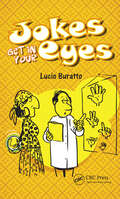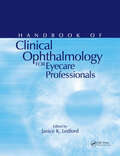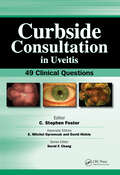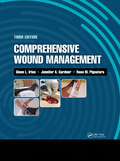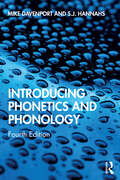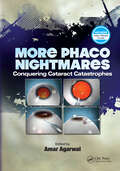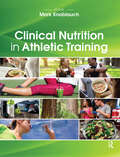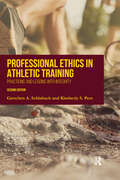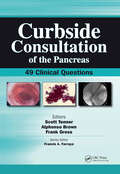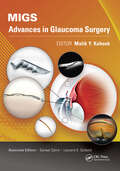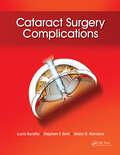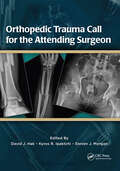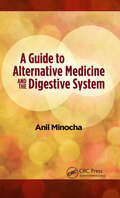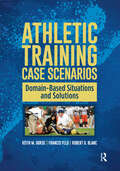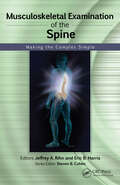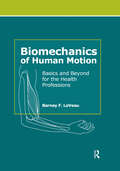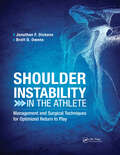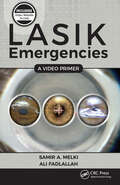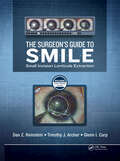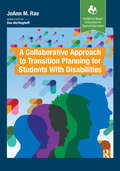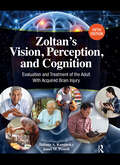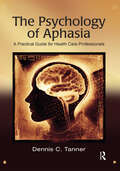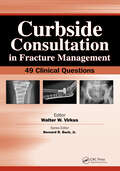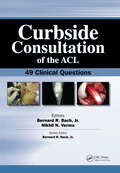- Table View
- List View
Jokes Get in Your Eyes
by Lucio BurattoOphthalmologists encounter patients every day, some who will be facing difficult and extremely delicate surgical procedures. As the physician-patient relationship begins and the ophthalmologist is working to properly diagnose, treat and manage the patient’s condition, they must also play a role in reducing patient anxiety and tension.Inside the pages of Jokes Get in Your Eyes, Dr. Lucio Buratto brings a lighter side to the ophthalmology profession. Sometimes a smile can be the first step to reducing patient anxiety and tension. Sometimes laughter can be therapeutic. Jokes Get in Your Eyes contains 40 Jokes and 80 cartoon illustrations—all in a pocket size handbook that can easily fit into a lab coat pocket. Reading thru Jokes Get in Your Eyes, ophthalmologists will be able to bring a smile to their day, as well share a joke or two among colleagues.From the Foreword:With his latest book, Jokes Get in Your Eyes, it is amazing that he was able to accumulate so many jokes related to the eyes. It is refreshing to have a physician who is so well rounded.”-Robert M. Sinskey, MD, Jules Stein Eye Institute, University of California at Los Angeles
Handbook of Clinical Ophthalmology for Eyecare Professionals (The Basic Bookshelf for Eyecare Professionals)
by Janice K. LedfordThe Basic Bookshelf for Eyecare Professionals is a series that provides fundamental and advanced material with a clinical approach to clinicians and students. A special effort was made to include information needed for the certification exams in ophthalmic and optometric assisting, low vision, surgical assisting, opticianry, and contact lens examiners.This handbook is a compilation of information from books in the Basic Bookshelf for Eyecare Professionals. This book serves as an ophthalmic pocket companion for the eyecare paraprofessional, complementary to the entire series. With 100 tables and illustrations throughout the text, the reader will find this an extremely useful guide covering essentially every aspect of patient care. Tables regarding tests, drugs, disorders, motility, first aid, microbiology, and more will have you pulling this book out frequently, even in the exam room. The condensed format makes it ideal for studying as well.
Curbside Consultation in Uveitis: 49 Clinical Questions (Curbside Consultation in Ophthalmology)
by Stephen FosterAre you looking for concise, practical answers to those questions that are often left unanswered by traditional references on uveitis? Are you seeking brief, evidence-based advice for the daily examination of patients? Curbside Consultation in Uveitis: 49 Clinical Questions provides quick and direct answers to the thorny questions most commonly posed during a “curbside consultation” between experienced clinicians. Dr. Stephen Foster has designed this unique reference in which uveitis specialists offer expert advice, preferences, and opinions on tough clinical questions commonly encountered by ophthalmologists, residents, and other health care professionals. The unique Q&A format provides quick access to current information related to uveitis with the simplicity of a conversation between two colleagues. Images, diagrams, and references are included to enhance the text and to illustrate clinical diagnoses and treatment plans. Curbside Consultation in Uveitis: 49 Clinical Questions provides information basic enough for residents while also incorporating expert pearls that even high-volume ophthalmologists will appreciate. Refractive surgeons, general ophthalmologists, and residents alike will enjoy the user-friendly and casual format. Some of the questions that are answered: • How do the results of the Systemic Immunosuppressive Therapy for Eye Disease (SITE) Cohort Study apply to the care of my patients with uveitis?• How should I evaluate and treat a patient with uveitis?• How should I treat macular edema in a patient with uveitis?• How should I treat a pregnant woman with macular threatening toxoplasmosis retinochoroiditis? • When should I refer a patient with uveitis to a uveitis specialist?
Comprehensive Wound Management
by Jennifer Gardner Glenn Irion Rose PignataroComprehensive Wound Management, Third Edition is back with a timely update providing a comprehensive overview of wounds---from etiology to intervention.Featuring more than 300 full-color images, photos, tables, and graphs to aid students in recognizing different types of wounds when performing examination and providing interventions, Comprehensive Wound Management, Third Edition goes beyond the call of duty of a traditional textbook. The book breaks down each of the common wound types, neuropathic, pressure, and vascular, into individual chapters that may be utilized for a holistic approach to learning or as stand-alone reading assignments.Comprehensive Wound Management, Third Edition also covers classes of interventions, plan of care, documentation, and other administrative concerns such as reimbursement and regulations that must be considered in real-life practice of wound management. A major emphasis is placed on teaching how to perform interventions instead of simply mentioning them in context.What’s new to the Third Edition: Updated terminology and other changes recently instituted by the National Pressure Injury Advisory Panel Up-to-date information regarding reimbursement and regulations Boxes with summaries of performing examinations and interventions Short-answer questions at the end of each chapter Included with the text are online supplemental materials for faculty use in the classroom.Comprehensive Wound Management, Third Edition proves to be as invaluable a text as its previous editions and remains a must-have resource for physical therapy students and clinicians, certified wound specialists, rehabilitation professionals, and any health care provider who is managing the treatment of wounds.
Introducing Phonetics and Phonology
by Mike Davenport S.J. HannahsIntended for the absolute beginner, Introducing Phonetics and Phonology requires no previous background in linguistics, phonetics or phonology. Starting with a grounding in phonetics and phonological theory, the book provides a base from which more advanced treatments may be approached. It begins with an examination of the foundations of articulatory and acoustic phonetics, moves on to the basic principles of phonology and ends with an outline of some further issues within contemporary phonology. Varieties of English, particularly Received Pronunciation and General American, form the focus of consideration, but aspects of the phonetics and phonology of other languages are discussed as well. This new edition includes revised exercises and examples; additional coverage of typology, autosegmental phonology and articulatory and acoustic phonetics; broader coverage of varieties that now features Australian English; and an extended Chapter 7 that includes more information on the relationship between phonetics and phonology.Introducing Phonetics and Phonology, 4th Edition remains the essential introduction for any students studying this topic for the first time.
More Phaco Nightmares: Conquering Cataract Catastrophes
by Amar AgarwalEven the most experienced cataract surgeon can encounter stressful situations in the operating room. With the new edition of More Phaco Nightmares: Conquering Cataract Catastrophes, surgeons can be prepared to manage unavoidable complications with ease.Dr. Amar Agarwal, along with over 35 of today’s cataract surgery leaders, explain all there is to know about phacoemulsification and bring their extensive experience with their own surgical nightmares. The book contains 5 sections that gradually escalate from the basics to nightmares, furnishing phaco surgeons with complicated scenarios and the essential guidance to assess, manage, and resolve.Featuring updated content and brand new, state-of-the-art chapters on a variety of complex situations, More Phaco Nightmares is the toolkit surgeons need to stay in control when facing unique and especially challenging intra- and postoperative complications.Sample chapters include: The Phaco Machine Air Pump, Gas-Forced Infusion, and Active Fluidics Intraoperative Floppy Iris Syndrome Single-Pass Four-Throw Pupilloplasty Management of Capsule Rupture at Cataract Surgery Malpositioned Intraocular Lens Optic Capture Glued Intraocular Lens Management and Prevention of Negative Dysphotopsia Pseudophakic Cystoid Macular Edema More than 350 illustrations and photographs supplement the text, providing visual as well as textual references for each case. Plus, an accompanying video website contains over 4 hours of new, original, high-quality video content, offering additional visual learning to demonstrate the techniques discussed.Offering cutting-edge information, More Phaco Nightmares: Conquering Cataract Catastrophes will guide surgeons on how to mitigate the common problems and unanticipated disasters that may arise for even the most experienced surgeons.
Clinical Nutrition in Athletic Training
by Mark KnoblauchClinical Nutrition in Athletic Training is the definitive nutrition textbook for athletic training educational programs, providing athletic trainers with foundational knowledge in clinical-based concepts specific to the field of nutrition.Editor Dr. Mark Knoblauch and his contributors draw upon nutrition-based requirements outlined in the 2020 Commission on Accreditation of Athletic Training Education (CAATE) educational standards, as well as from the input of practicing athletic trainers and dietitians.This book gives an overview of the energy systems, macronutrients, and micronutrients that are often intertwined with nutrition. Each chapter includes real-life tips from the field, providing readers with a unique and practical learning experience.What’s covered in Clinical Nutrition in Athletic Training: Supplements and their use in clinical nutrition A detailed overview of fluid management Chapters specifically devoted to nutrition and disease, as well as eating disorders How to interpret food labeling An outline written by a dietitian on how to conduct a proper nutrition counseling session Tips on discussing nutrition with patients and athletes Clinical Nutrition in Athletic Training explores how proper nutrition may be able to reduce the incidence of injury in some individuals. With sections focused on direct patient care aspects of nutrition and how nutrition is involved in weight management, this book also examines how nutrition requirements change based on the type and level of physical activity an individual is engaged in.Clinical Nutrition in Athletic Training is an easy-to-read resource that will equip athletic trainers with the knowledge to care for and educate their patients and athletes on nutrition.
Professional Ethics in Athletic Training: Practicing and Leading With Integrity
by Gretchen Schlabach Kimberly PeerA comprehensive textbook for athletic training students, educators, and practitioners, Professional Ethics in Athletic Training: Practicing and Leading With Integrity, Second Edition provides a framework for understanding and applying ethical principles across the career span of an athletic training professional.Esteemed authors Gretchen A. Schlabach and Kimberly S. Peer explain the necessity of practicing and leading with integrity across one’s athletic training career. The text explores issues related to cultural competence and professional behavior as well as ethical leadership and decision-making skills that both inform and transcend the athletic training profession.Each chapter is accompanied by frameworks that lead to both analysis and awareness of legal statutes, ethical principles, regulatory practice acts, and professional practice standards that encourage responsible reasoning and conduct. Contemporary journal articles can also be found in every chapter to help readers make connections between content and clinical practice. The text also includes assessment tools, sample models for ethical decision making, writing about moral issues, and sample course design and delivery for teaching ethics. Included in the instructor’s materials are nearly 50 cases to promote critical thinking as well as learning activities for each chapter. Included with the text are online supplemental materials for faculty use in the classroom.Covering all levels of ethical practice—from the entry-level student to the experienced athletic trainer—Professional Ethics in Athletic Training synthesizes and integrates ethical theory and practical application for those who practice and lead with integrity.
Curbside Consultation of the Pancreas: 49 Clinical Questions (Curbside Consultation in Gastroenterology)
by Frank G. Gress Alphonso Brown Scott TennerAre you looking for concise, practical answers to questions that are often left unanswered by traditional pancreatic disease references? Are you seeking brief, evidence-based advice for complicated cases or complications? Curbside Consultation of the Pancreas: 49 Clinical Questions provides quick and direct answers to the thorny questions commonly posed during a “curbside consultation” between colleagues.Dr. Scott Tenner, Dr. Alphonso Brown, and Dr. Frank Gress have designed this unique reference, which offers expert advice, preferences, and opinions on tough clinical questions commonly associated with pancreatic disease. The unique Q&A format provides quick access to current information related to pancreatic disease with the simplicity of a conversation between two colleagues. Numerous images, diagrams, and references are included to enhance the text and to illustrate the treatment of pancreatic disease patients.Curbside Consultation of the Pancreas: 49 Clinical Questions provides information basic enough for residents while also incorporating expert advice that even high-volume clinicians will appreciate. Gastroenterologists, fellows and residents in training, surgical attendings, and surgical residents will benefit from the user-friendly and casual format and the expert advice contained within.Some of the questions that are answered: How do I determine the amount of fluids to provide to patients with acute pancreatitis? When should antibiotics be used in acute pancreatitis? How do I determine the timing of re-feeding patients with acute pancreatitis? What is the best way to treat pain in patients with chronic pancreatitis? How should I define the best approach to a pseudocyst?
MIGS: Advances in Glaucoma Surgery
by Malik KahookWith a revolution in the surgical management of mild to moderate glaucoma, new procedures allow for the use of microinvasive techniques that avoid disruption of the conjunctiva and formation of a bleb. These approaches range from laser therapies targeting the outflow system of the eye to the implantation of miniature devices in Schlemm’s canal or the suprachoroidal space. The emergence of this new branch of glaucoma surgery, often coupled with micro-incisional cataract surgery, requires the practicing surgeon to learn about anatomical nuances to ensure success.MIGS: Advances in Glaucoma Surgery will aid the novice resident as well as the seasoned ophthalmic surgeon facing these new issues in glaucoma treatment. The book addresses preoperative patient selection advice, intraoperative pearls for success, and post operative management skills, which are some of the important aspects of the process towards the adoption of MIGS.Why you will want to read MIGS: Advances in Glaucoma Surgery:• Forward thinking contributions from seasoned MIGS experts who have intimate knowledge of the devices benefits and potential pitfalls in their use• Basic knowledge is provided that will allow each surgeon to tailor their treatment plan while leveling the learning curve• Assists in indentifying patients with a milder form of the disease and higher target pressures who may benefit from the MIGS devicesMIGS: Advances in Glaucoma Surgery is the first book of its kind to cover the range of devices in this arena using expert contributors and offering real world pearls for practice that can be used in the operating room. Practicing cataract and glaucoma physicians, residents, and fellows will benefit from this timely resource as the thought process for how to treat glaucoma has advanced.
Cataract Surgery Complications
by Lucio Buratto Stephen Brint Mario RomanoCataract Surgery Complications offer the latest techniques in prevention and management of all intra and postoperative complications faced by today’s surgeons performing cataract surgery. Dr. Lucio Buratto; Dr. Stephen Brint; and Dr. Mario R. Romano are joined by 11 expert contributors who provide step-by-step approach to facilitate how to comfortably manage complications, including instrumentation and technique.Cataract Surgery Complications covers a wide variety of topics including hydrodissection maneuvers, posterior capsule rupture; endophthalmitis; corneal incisions, and phacoemulsification.Supplemented by more than 200 color illustrations, diagrams, and references, all surgeons, from beginner to expert will want this unique resource by their side.
Orthopedic Trauma Call for the Attending Surgeon
by Steven Morgan David Hak Kyros IpaktchiOrthopedic Trauma Call for the Attending Surgeon is a clinically focused book that will help guide the orthopedic surgeon through the most commonly encountered injuries when on call.Drs. David J. Hak, Kyros R. Ipaktchi and Steven Morgan are joined by over 50 leading experts to provide a succinct and quick review of the key points that will allow you to provide patients with expert and immediate care.Inside Orthopedic Trauma Call for the Attending Surgeon each chapter is written in an easy to read bulleted format that will allow for a quick review of the key facts you need to know while taking call. Chapters also cover emergent and definitive management and provide guidelines for when to consider referral to a higher level of care. The authors also share their tips and tricks for successful outcomes, while highlighting potential pitfalls and how to avoid them. Since it can be difficult to find time to read a traditional textbook or review article, Orthopedic Trauma Call for the Attending Surgeon is perfect for orthopedic surgeons, physician assistants, extenders who cover ER call, and orthopedic trainees.
Combat Orthopedic Surgery: Lessons Learned in Irag and Afghanistan
by Brett Owens Philip BelmontDuring the course of the Iraq and Afghanistan Wars, military orthopedic surgeons have made significant technical and philosophic changes in the treatment of musculoskeletal combat casualties. The widespread use of individual and vehicular body armor, evolution of enemy tactics to include its reliance on improvised explosive devices, and the effectiveness of treatment rendered at military treatment facilities have resulted in a large burden of complex orthopedic injuries. Combat Orthopedic Surgery: Lessons Learned in Iraq and Afghanistan represents and recognizes the latest advances in musculoskeletal surgical care performed to treat today’s US military servicemembers.Editors LTC Brett D. Owens, MD and LTC Philip J. Belmont Jr., MD have brought together the leading military orthopedic surgeons to relay their clinical orthopedic surgery expertise, as well as to discuss how to provide optimal care for combat casualties both initially in theater and definitively at tertiary care facilities within the United States.Combat Orthopedic Surgery: Lessons Learned in Iraq and Afghanistan is divided into five sections, with the first being devoted to an overview of general topics. The second section covers scientific topics and their clinical application to musculoskeletal combat casualties. The final three sections are clinically focused on the upper extremity, lower extremity, and spine and pelvic injuries, with many illustrative case examples referenced throughout.Most clinical chapters contain: Introduction/historical background Epidemiology Management in theater Definitive management Surgical techniques Outcomes Complications Combat Orthopedic Surgery: Lessons Learned in Iraq and Afghanistan will be the definitive academic record that represents how orthopedic surgeons currently manage and treat musculoskeletal combat casualties.
A Guide to Alternative Medicine and the Digestive System
by Anil MinochaA Guide to Alternative Medicine and the Digestive System is unique in that it provides answers to many practical clinical questions, all in one comprehensive resource. This single-authored handbook by Dr. Anil Minocha contains content supported by close to a 1,000 scientific citations. A Guide to Alternative Medicine and the Digestive System discusses the supportive evidence, and addresses safety issues, side-effects, and drug interactions.Dr. Anil Minocha is Board-certified in gastroenterology, internal medicine, nutrition as well as fellowship trained in clinical pharmacology and medical toxicology. This extensive background brings a systematic approach to evaluating, treating, and managing patients with alternative medicine options when treating conditions related to the digestive system.Readers will find more than 70 chapters of succinct information written in a user-friendly format inside A Guide to Alternative Medicine and the Digestive System.“Dr. Anil Minocha is well-known for writing useful, practical guides for quality care. His newest text, A Guide to Alternative Medicine and the Digestive System is no disappointment. This is an eloquent and elegant evidence-based approach to a challenging area.”-Jack A. Di Palma, MD, University of South Alabama, Former President of the American College of Gastroenterology“Dr. Minocha is to be applauded for his courage in tackling an issue, CAM, that the medical profession has traditionally chosen to ignore in the hope that it would simply go away. That CAM has stubbornly refused to disappear is a testament to its popularity with the general population and demands that we take it seriously, analyze why it is used and by whom and critically assess its efficacy and risks. For providing us with an accessible, fair and comprehensive critique of CAM in the context of modern medical practice, we all owe a debt of gratitude to Dr. Minocha."-Eamonn Quigley, MD, University College Cork, Ireland , Former President of the American College of Gastroenterology
Athletic Training Case Scenarios: Domain-Based Situations and Solutions
by Francis Feld Keith Gorse Robert BlancEvery case that athletic trainers respond to is unique, but by exposing themselves to a variety of scenarios, they can be prepared for almost any situation. Case studies are the easiest way to find this information, but oftentimes, they come in the form of informal anecdotes or only relate to very specific subjects. Athletic Training Case Scenarios: Domain-Based Situations and Solutions is designed to fill this gap by providing a large number of studies from all five of the domains of athletic training. Keith M. Gorse, Francis Feld, and Robert O. Blanc have gathered true-to-life scenarios for each of the five domains of athletic training, resulting in expert advice on the best response to many possible scenarios. These scenarios were shared by the certified athletic trainers who originally responded to them coming from their work in industrial settings, high schools, colleges, professional teams, and sports medicine clinics. Each scenario features the actual case as it was first assessed by the athletic trainer in order to give readers an opportunity to use their own judgment and decide the best course of action before the original athletic trainer’s own response and recommendations are given. Organized by domain, readers will be able to easily find examples of any case they could imagine. Each domain (prevention, evaluation and diagnosis, emergency care, treatment and rehabilitation, and organizational and professional health) has over a dozen scenarios designed to encourage critical thinking. This format gives readers the closest thing to a crash-course by exposing them to a diverse array of cases and situations. Athletic training students and clinicians will appreciate the wide range of cases presented in Athletic Training Case Scenarios: Domain-Based Situations and Solutions, providing them with the strong knowledge base they will need to respond to any situation they may experience themselves.
Musculoskeletal Examination of the Spine: Making the Complex Simple
by Eric Harris Jeffrey RihnThe physical examination of the spine can be a complex topic for professionals with all levels of clinical experience. How can advance concepts be taught in a user-friendly, clear format, while still providing necessary information for effective diagnosis and treatment of the spine?Musculoskeletal Examination of the Spine: Making the Complex Simple by Drs. Jeffrey A. Rihn and Eric B. Harris answers these questions. Written by experts, this easy-to-carry book provides a thorough review of the most common pathologic spine conditions, techniques for diagnosis, as well as the appropriate treatment for each condition.Musculoskeletal Examination of the Spine: Making the Complex Simple contains clear photographic demonstrations, tables, and charts throughout its pages, allowing a thorough and concise examination of the spine.A Glance at some of what is covered inside:• Physical Examinationo Basics and specific tests of the examination of the cervical and thoracolumbar spine• General Imagingo Basics of general imaging of the degenerative and traumatic injuries of the spine• Common Conditionso Cervical spondylosis, Lumbar disk herniation, Diskitis and vertebral osteomyelitis of the spine, and moreMusculoskeletal Examination of the Spine: Making the Complex Simple contains essential information to successfully take a complex subject, and bring it to a level that will be welcomed by all orthopedic residents, attendings, physical therapists, athletic trainers, medical students in training, and other healthcare providers.
Biomechanics of Human Motion: Basics and Beyond for the Health Professions
by Barney LeVeauBiomechanics of Human Motion: Basics and Beyond for the Health Professions presents a straightforward approach to the basic principles, theories and applications of biomechanics and provides numerous techniques and examples for approaching biomechanical situations enhanced by healthcare professionals.Building on his previous work, Dr. Barney LeVeau uses clearly defined, concise terms and real-life applications rather than advanced mathematics to make teaching and learning biomechanics easier. Based upon the concept of force, the text illustrates how force is applied to the human body and how the body applies force to various objects. The emphasis is upon the pertinent factors that guide the reader to an understanding of biomechanics at a beginning level.Chapter Topics Include:• Strength of material such as loading and stress-strain relationships• Composition and Resolution of Forces such as graphic method and mathematical method• Equilibrium such as static, first condition and second condition• Dynamics such as kinematics and kinetics • Application such as stability and balance, motion analysis, and gaitWhat’s Inside:• Simple explanations of biological & mechanical concepts• Contemporary articles at the end of each chapter providing readers with information beyond the basics• Over 240 images illustrate biomechanical situations and computations• User-friendly, uncomplicated mathematical formulas and examplesBiomechanics of Human Motion: Basics and Beyond for the Health Professions provides students and clinicians of all allied health professions with a basic background and solid foundation on which to build a solid understanding of force and biomechanics.
Shoulder Instability in the Athlete: Management and Surgical Techniques for Optimized Return to Play
by Jonathan Dickens Brett OwensShoulder Instability in the Athlete: Management and Surgical Techniques for Optimized Return to Play is a groundbreaking text that covers all aspects of care for athletes with shoulder instability—from on-the-field management and treatment to successful return to play. Edited by Drs. Jonathan F. Dickens and Brett D. Owens and featuring the expertise of internationally recognized surgeons who specialize in shoulder instability in high-level athletes, Shoulder Instability in the Athlete is a unique collaboration applicable across a variety of professional areas. This will be the premiere reference for physicians, surgeons, therapists, trainers, and students involved in the care of athletes. Each chapter of Shoulder Instability in the Athlete reviews cutting-edge clinical and surgical techniques, as well as outcomes and return to play criteria. In-depth analysis of appropriate literature and outcomes specific to the athlete population are also presented. Important sections within the text include: Principles for the team physician Anterior instability Posterior instability Special topics in instability By focusing specifically on the unique and challenging dilemma of caring for the athlete with shoulder instability, Shoulder Instability in the Athlete will be a valuable reference for all health professionals who manage athletes.
LASIK Emergencies: A Video Primer
by Samir A. Melki Ali FadlallahFemtosecond-assisted laser in-situ keratomileusis flaps have revolutionized refractive surgery since their introduction. The use of the femtosecond laser to create the LASIK flap has led to an improvement in the safety profile of the flap creation step as compared to the mechanical microkeratome. Although this laser is exceedingly safe, complications still do occur. LASIK Emergencies: A Video Primer focuses specifically on the different flap complications that are still known to occur and their management.Designed as a narrated video-based book of ophthalmic surgeries, LASIK Emergencies covers the entire spectrum of Intralase flap complications. With 15 chapters, this book and accompanying website contains nearly 4 hours of state-of-the-art video teaching.Drs. Samir Melki and Ali Fadlallah have designed LASIK Emergencies so that each chapter focuses on a specific complication and its management, and features multiple videos for each. Each video is edited in such a way that the viewer can quickly grasp all the relevant information without having to sit through extensive, unedited surgical videos.Some Complications Covered: Loss of suction Air bubbles in the Anterior Chamber Irregular Flaps Subconjunctival hemorrhage and bleeding Ophthalmologists, laser ophthalmic technicians, and optometrists alike will appreciate this unique resource, as LASIK Emergencies: A Video Primer covers the entire spectrum of LASIK complications in a detailed, yet digestible manner.
The Surgeon’s Guide to SMILE: Small Incision Lenticule Extraction
by Dan Reinstein Timothy Archer Glenn CarpCorneal refractive surgeons are likely already familiar with the theory behind small incision lenticule extraction (SMILE) and the excellent postoperative outcomes it can achieve, but they were left without a thorough and comprehensive guide to performing the procedure, until now. The Surgeon’s Guide to SMILE: Small Incision Lenticule Extraction is designed to provide surgeons who are interested in starting or are already performing SMILE with a detailed description of the preoperative assessment, surgical technique, and postoperative management of SMILE treatments.This book by Professor Dan Z. Reinstein, Mr. Timothy J. Archer, and Dr. Glenn I. Carp is designed as a surgical video-fellowship, focusing on the granular details of every aspect of patient preparation and management with special attention to how to perform a perfect routine SMILE procedure. The protocols and methods are sourced in both the published scientific evidence and the extensive experience and expertise of the authors. It also includes tips and tricks of how to manage the full range of possible scenarios and complications that can occur during and after a SMILE surgery. Each process described in the book is accompanied by at least one, and in many cases numerous, narrated video examples.Bonus!This dynamic learning tool is supplemented by the SMILE video library containing over 16 hours of surgical videos and tutorials hosted on a companion website.The succinct and demonstrative style of The Surgeon’s Guide to SMILE: Small Incision Lenticule Extraction will help novice and experienced SMILE surgeons alike learn important techniques and improve their outcomes.From the Foreword:“The reader is in for a treat, receiving authoritative technical information from seasoned leaders in the field of refractive surgery, who have attained tremendous experience in excimer laser ablation and who have also been on the forefront of scientific evaluation of the new femtosecond only surgical approach that is SMILE.”-J. Bradley Randleman, MD, University of Southern California, Los Angeles, CA
A Collaborative Approach to Transition Planning for Students with Disabilities (Evidence-Based Instruction in Special Education)
by JoAnn M. RaeA Collaborative Approach to Transition Planning for Students with Disabilities is designed to inform aspiring special education teachers, special education teams, transition planning specialists and school administrators about the complex process of transition planning and to meet the transition requirements of special education legislation. Author Dr. JoAnn Rae has been in the field of special education for 34 years, in service as a special education teacher, special education administrator, teacher certification supervisor and as college faculty. The framework she outlines is specially designed to advance students’ involvement and participation in their lives, not only in the presence of the most severe sensory and intellectual disabilities, but also in the case of multiple disabilities. Unique scenarios not typically seen in other textbooks, such as IEP team disagreements, students with terminal illnesses, students with ill or overworked parents or students living in poverty are also explored. The text also includes: Descriptions of research-based practices to maximize students’ self-determination, autonomy, goal setting and ability to have successful life experiences Opportunities to integrate knowledge with practice by providing strategies that relate to the real-life difficulties students and transition planning specialists may encounter Easy-to-replicate communication tools, such as letters to students and parents, as examples to enhance collaboration Methods for teachers to effectively promote and increase student involvement and collaboration by using structured and interactive interviews A Collaborative Approach to Transition Planning for Students with Disabilities reflects the universal challenges that teachers, families and finally, the students themselves face, as they progress through school with a disability. For students with disabilities, the key component to successful transition planning is creating a collaborative atmosphere that allows them to be successful. This book promises to serve as an essential resource to all who are dedicated to that goal.
Zoltan’s Vision, Perception, and Cognition: Evaluation and Treatment of the Adult with Acquired Brain Injury
by Tatiana Kaminsky Janet PowellThe go-to guide for nearly 50 years for occupational therapists working with adults with visual, perceptual, and cognitive deficits after brain injury is back for a Fifth Edition.Zoltan’s Vision, Perception, and Cognition: Evaluation and Treatment of the Adult With Acquired Brain Injury, Fifth Edition maintains the core foundation laid in previous editions while drawing upon Drs. Tatiana A. Kaminsky and Janet M. Powell’s 60-plus years combined of clinical, teaching, and research experience in adult neuro-based rehabilitation.This best-selling text translates the available research and theory into application for practice. The result is a comprehensive, accessible, up-to-date, and evidence-informed textbook with a strong occupation-based focus, detailing occupational therapy evaluation and treatment practices for adults with visual, perceptual, and cognitive deficits after brain injury.What’s new in the Fifth Edition: An emphasis on functional cognition, occupational focus, and changes in approaches to rehabilitation Clinical examples from adult neurorehabilitation to ease understanding Up-to-date evidence and everyday technology implementation Tips for collaborating with a team of practitioners New case examples Included with the text are online supplemental materials for faculty use in the classroom.Zoltan’s Vision, Perception, and Cognition: Evaluation and Treatment of the Adult With Acquired Brain Injury, Fifth Edition includes key updates to stay current while maintaining the essence of its previous editions.
The Psychology of Aphasia: A Practical Guide for Health Care Professionals
by Dennis TannerBrain damage predisposes many persons with aphasia to a variety of psychological reactions, which are precipitated by stress and loss, and perpetuated by impaired verbal defense mechanisms and coping styles. Most of the literature on recovery from aphasia does not sufficiently address the overwhelming confusion and disorder that aphasia can cause in the patient, the communication partner, the communication between them, and their shared environment. The Psychology of Aphasia: A Practical Guide for Health Care Professionals fills this serious void.Dr. Dennis Tanner has studied the psychology of aphasia as a scientist and professor as well as evaluated and treated thousands of patients with neuropathologies of speech and language as a clinician over his 40-year career. This text represents the culmination of his efforts to understand the major psychological aspects of this complex communications disorder.The only text specifically addressing this topic, The Psychology of Aphasia is designed to provide the reader with a sound foundation of scientific information with current and historical scientific references spanning many decades. It delves into the certain psychological, emotional, and behavioral reactions that occur because of brain and nervous system damage, the psychological defenses and coping styles of patients and the verbal defense mechanisms they are deprived of due to their loss of language, as well as the grief response to the loss of physical abilities, valued objects, and the breakdown in communication.Each chapter is written in accessible language and provides practical case studies, illustrations, and examples of each major concept to reinforce learning.The whole aphasia rehabilitation team of speech-language pathologists, psychologists, physical and occupational therapists, social workers, physicians, nurses, home health aides, and family members will find The Psychology of Aphasia: A Practical Guide for Health Care Professionals an enlightening tool to bridge the gap between theoretical and practical issues in treating actual patients.
Curbside Consultation in Fracture Management: 49 Clinical Questions (Curbside Consultation in Orthopedics)
by Walter VirkusAre you looking for concise, practical answers to those questions that are often left unanswered by traditional fracture management references? Are you seeking brief, evidence-based advice for complicated cases or controversial decisions? Curbside Consultation in Fracture Management: 49 Clinical Questions provides quick answers to the thorny questions most commonly posed during a “curbside consultation” between orthopedic surgical colleagues. Dr. Walter Virkus has designed this unique reference which offers expert advice, preferences, and opinions on tough clinical questions commonly associated with fracture management. The unique Q&A format provides quick access to current information related to fracture management with the simplicity of a conversation between two colleagues. Numerous images, diagrams, and references are included to enhance the text and to illustrate the management of fractures.Curbside Consultation Fracture Management: 49 Clinical Questions provides information basic enough for residents while also incorporating expert advice that even high-volume clinicians will appreciate. Practicing orthopedists, orthopedic residents, and non-physician personnel will benefit from the user-friendly and casual format and the expert advice contained within.Some of the questions that are answered: • There is a patient in the ER with a femur fracture and humeral shaft fracture. Should I fix the humerus with a nail or a plate? • How do you decide which pelvis fractures need surgery? • What is your choice for a displaced femoral neck fracture in a 65-year-old: ORIF, hemiarthroplasty, or total hip arthroplasty? • I have a 45 Year-old woman with a bicondylar tibial plateau fracture. What type of fixation should I use? • I have a 38 Year-old woman with a distal tibia spiral fracture. Should I try to nail this or just plate it? • When do you use locking plates?
Curbside Consultation of the ACL: 49 Clinical Questions (Curbside Consultation in Orthopedics)
by Nikhil N. Verma Bernard R. BachAre you looking for concise, practical answers to those questions that are often left unanswered by traditional ACL references? Are you seeking brief, evidence-based advice for complicated cases or complications? Curbside Consultation of the ACL: 49 Clinical Questions provides quick answers to the many questions most commonly posed during a “curbside consultation” between surgical colleagues. Drs. Bernard R. Bach, Jr. and Nikhil N. Verma have designed this unique reference which offers expert advice, preferences, and opinions on tough clinical questions commonly associated with ACL management. The unique Q&A format provides quick access to current information related to ACL management with the simplicity of a conversation between two colleagues. Numerous images, diagrams, and references are included to enhance the text and to illustrate the management of ACL issues.Curbside Consultation of the ACL: 49 Clinical Questions provides information basic enough for residents while also incorporating expert advice that even high-volume clinicians will appreciate. Practicing orthopedic surgeons, orthopedic residents and medical students will benefit from the user-friendly and casual format and the expert advice contained within.Some of the questions that are answered: How do you evaluate the failed ACL reconstruction? What tricks do you have to avoid creation of a “vertical” tunnel when drilling a transtibial tunnel? How do you evaluate, manage, and prevent motion problems? How do you determine tibial tunnel position to optimize graft length and femoral tunnel position when performing an endoscopic technique? How do you manage the expanded femoral or tibial tunnel in a failed ACL patient? How do you manage the adolescent with open growth plates who has sustained an ACL injury?
